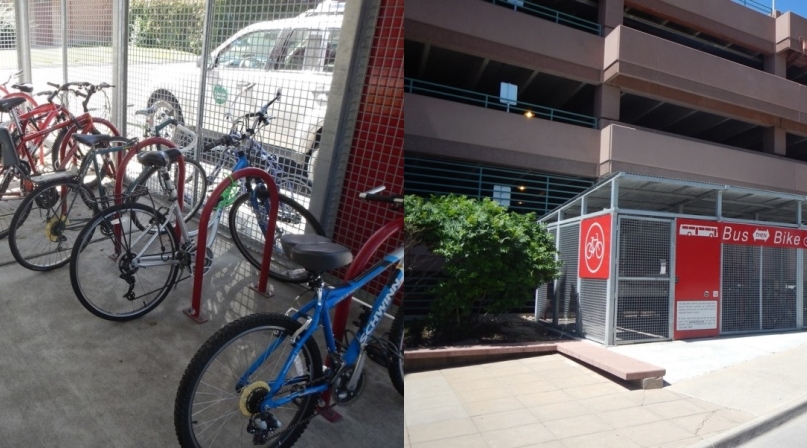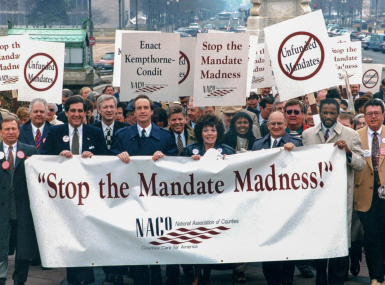Bright Ideas - April 4, 2016

Interior and exterior views of the bus-to-bike shelters in Boulder County, Colo. Photo courtesy of Boulder County, Colo.Commuters’ Bikes Have a Safe Place to Stay
Problem: Biking to work or home from the end of bus lines was unattractive to Boulder County workers.
Solution: The Roads and Transportation Department built bike shelters with key-card access for cyclists to leave their bikes near local bus stations overnight.
Part of Boulder County, Colo.’s allure is also part of a problem for workers.
The same open space programs that protect land from development have also put miles between where the county’s bus system stretches and where many offices are located, putting transit riders in a frustrating place in their commutes. And for many who work in Denver and take a regional bus, getting to the bus stop from home can be a lot easier on a bike.
Surveys conducted by the Roads and Transportation Department showed that half of the people bringing bikes on the buses, which can carry roughly six bikes at most, did so because their destination was too far from the last bus stop to walk.
Bringing a bike on the bus once, to use to get to work from the bus to the office, was no picnic, either. The options for locking their bikes near the bus stops did not inspire much confidence, with the specter of theft, vandalism or weather damage threatening the bikes overnight.
The county responded by building a series of shelters near some major bus stops. They are basically locked cages with roofs in which commuters can lock their bikes for hours at a time. After formally applying for the Bus Then Bike program, users get electronic keycards that give them access to the shelters.
“People can use them as a last-mile solution or a first-mile solution,” said Alex Hyde-Wright, a county bicycle planner. “They can take them from home to the bus or from the bus to the office. And some do both.”
The first three shelters built can hold 31 bikes each, costing $70,000 apiece. A $115,000 grant from the Denver Regional Council of Governments helped to defray those costs. The City of Boulder paid for a $405,000 custom shelter with a 140-bike capacity.
The city and county are considering building a bike hub with a 200-bike capacity, showers, lockers and a bike repair shop that could top $2 million for construction.
Annual maintenance costs for the four shelters totals $3,000, plus roughly six hours of staff time weekly.
Through March 2015, the program had distributed 565 access cards, with more than half signing up in the prior three months. A year later, that number had almost doubled.
But despite more than 1,000 users and 233 spots, the shelters aren’t bursting at the seams, and the key card system, which can record usage, explains why.
“We were expecting people to sign and use it five days a week, but that’s not happening as much,” Hyde-Wright said. “People are signing up and using the shelters every now and then. Many people are using them socially,” for incidental trips, not part of a regular commute.
The 140-spot downtown Boulder shelter averages about half full, and so far, the county isn’t talking about new policies to manage use.
“We’re probably still a few years away from that,” Hyde-Wright said. “We might look at charging for participation or going first-come-first-served in the shelters.”
Hyde-Wright uses the shelters when he travels to Denver.
The drawbacks, he said, come from being part of a system over which the county doesn’t have more control.
“Our shelters succeed or fail based on the bike network, which is part of the overall transportation system,” he said. “Our urban fabric was built for cars, so bringing multimodal options into the picture will be slow going, and the drop in gas prices has made it easier for people to continue driving.”
But he’s optimistic that the shelters will see even more use when economics prompt commuters to look into bicycling.
“We’re laying the groundwork for when there’s a financial incentive to ride your bike,” he said.
Bright Ideas features noteworthy and award-winning programs.
Attachments
Related News

CMS issues new guidance on Medicaid Community Engagement Requirements
On December 8, the Centers for Medicare & Medicaid Services (CMS) released a Medicaid and CHIP Services Informational Bulletin (CIB) directing states on how to implement the Medicaid community engagement requirements enacted under Section 71119 of the One Big Beautiful Bill Act legislation (Public Law 119-21), or H.R. 1.

U.S. House of Representatives passes SPEED Act and other permitting reform bills
On December 18, the U.S. House of Representatives passed the SPEED Act (H.R. 4776). The SPEED Act would strengthen county involvement in decision-making and make needed commonsense reforms to the federal environmental review process.

